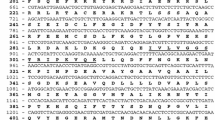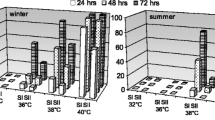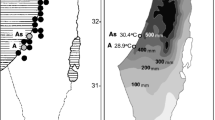Abstract
The Mediterranean land snail Xeropicta derbentina forms huge populations in Southern France. In order to characterize heat exposure and the induction of the 70-kD heat shock protein (Hsp70) response system during the life cycle of this snail, a selected population from the Vaucluse area, Provence, was investigated encompassing the issues of morphological life cycle parameters (shell size and colouration), the daily courses of heat exposure at different heights above the ground, of shell temperature, and that of the individual Hsp70 levels. The study covered all four seasons of the year 2011. Snails were found to be annual, reaching their final size in August. The shell colouration pattern showed high variation in juveniles (spring) with a strong tendency towards becoming uniformly white at old age in autumn. In all seasons, ambient air temperature decreased with increasing distance from the ground surface during daytime while remaining constantly low in the night. Overall, the Hsp70 level of individuals followed the ambient temperature during diurnal and seasonal variations. Correlation analysis revealed a positive association of individual shell temperature and Hsp70 level for the most part of the life cycle of the snails until late summer, whereas a negative correlation was found for aged animals indicating senescence effects on the capacity of the stress response system.






Similar content being viewed by others
References
Abdel-Rehim AH (1983) The effects of temperature and humidity on the nocturnal activity of different shell colour morphs of the land snail Arianta arbustorum. Biol J Linn Soc 20(4):385–395. doi:10.1111/j.1095-8312.1983.tb01599.x
Altena COR (1960) On the occurrence of a species of Xeropicta in France. Basteria 24:21–25
Arad Z, Mizrahi T, Goldenberg S, Heller J (2010) Natural annual cycle of heat shock protein expression in land snails: desert versus Mediterranean species of Sphincterochila. J Exp Biol 213(20):3487–3495. doi:10.1242/jeb.047670
Arts M, Schill RO, Knigge T, Eckwert H, Kammenga JE, Köhler HR (2004) Stress proteins (hsp70, hsp60) induced in isopods and nematodes by field exposure to metals in a gradient near Avonmouth, UK. Ecotoxicology 13(8):739–755. doi:10.1007/s10646-003-4473-5
Aubry S, Labaune C, Magnin F, Kiss L (2005) Habitat and integration within indigenous communities of Xeropicta derbentina (Gastropoda: Hygromiidae) a recently introduced land snail in south-eastern France. Divers Distrib 11(6):539–547. doi:10.1111/j.1366-9516.2005.00189.x
Aubry S, Labaune C, Magnin F, Roche P, Kiss L (2006) Active and passive dispersal of an invading land snail in Mediterranean France. J Anim Ecol 75(3):802–813. doi:10.1111/j.1365-2656.2006.01100.x
Bradford MM (1976) A rapid and sensitive method for the quantitation of microgram quantities of protein utilizing the principle of protein dye binding. Anal Biochem 72(1–2):248–254. doi:10.1006/abio.1976.9999
Daugaard M, Rohde M, Jäättelä M (2007) The heat shock protein 70 family: Highly homologous proteins with overlapping and distinct functions. FEBS Lett 581(19):3702–3710. doi:10.1016/j.febslet.2007.05.039
Di Lellis M, Seifan M, Troschinski S, Mazzia C, Capowiez Y, Triebskorn R, Köhler H-R (2012) Solar radiation stress in climbing snails: behavioural and intrinsic features define the Hsp70 level in natural populations of Xeropicta derbentina (Pulmonata). Cell Stress and Chaperones:1–11 IN PRESS. doi:10.1007/s12192-012-0344-4
Dittbrenner N, Lazzara R, Köhler H-R, Mazzia C, Capowiez Y, Triebskorn R (2009) Heat tolerance in Mediterranean land snails: histopathology after exposure to different temperature regimes. Journal of Molluscan Studies 75(1):9–18. doi:10.1093/mollus/eyn033
Eckwert H, Alberti G, Köhler H-R (1997) The induction of stress proteins (hsp) in Oniscus asellus (Isopoda) as a molecular marker of multiple heavy metal exposure: I. Principles and toxicological assessment Ecotoxicology 6(5):249–262. doi:10.1023/a:1018682928839
Feder ME, Hofmann GE (1999) Heat-shock proteins, molecular chaperones, and the stress response: Evolutionary and ecological physiology. Annual Reviews of Physiology 61:243–282. doi:10.1146/annurev.physiol.61.1.243
Herreid CF II (1977) Metabolism of land snails (Otala lactea) during dormancy, arousal, and activity. Comparative Biochemistry and Physiology Part A: Physiology 56(2):211–215. doi:10.1016/0300-9629(77)90187-6
Hofmann GE, Buckley BA, Airaksinen S, Keen JE, Somero GN (2000) Heat-shock protein expression is absent in the antarctic fish Trematomus bernacchii (family Nototheniidae). J Exp Biol 203(15):2331–2339
Kiang JG, Tsokos GC (1998) Heat Shock Protein 70 kDa: Molecular Biology, Biochemistry, and Physiology. Pharmacol Ther 80(2):183–201. doi:10.1016/s0163-7258(98)00028-x
Kiss L, Labaune C, Magnin F, Aubry S (2005) Plasticity of the life cycle of Xeropicta derbentina (Krynicki, 1836), a recently introduced snail in mediterranean France. Journal of Molluscan Studies 71(3):221–231. doi:10.1093/mollus/eyi030
Köhler H-R, Bartussek C, Eckwert H, Farian K, Gränzer S, Knigge T, Kunz N (2001) The hepatic stress protein (hsp70) response to interacting abiotic parameters in fish exposed to various levels of pollution. Journal of Aquatic Ecosystem Stress and Recovery (Formerly Journal of Aquatic Ecosystem Health) 8(3):261–279. doi:10.1023/a:1012935931161
Köhler HR (2009) Die Rolle von Stressproteinen bei der Anpassung an Umweltbedingungen: Ökophysiologische, ökotoxikologische und evolutionsbiologische Implikationen. Umweltwissenschaften und Schadstoff-Forschung 21(2):150–159. doi:10.1007/s12302-009-0041-9
Köhler H-R, Lazzara R, Dittbrenner N, Capowiez Y, Mazzia C, Triebskorn R (2009) Snail phenotypic variation and stress proteins: do different heat response strategies contribute to Waddington's widget in field populations? Journal of Experimental Zoology Part B: Molecular and Developmental Evolution 312B(2):136–147. doi:10.1002/jez.b.21253
Mayer M, Bukau B (2005) Hsp70 chaperones: Cellular functions and molecular mechanism. Cellular and Molecular Life Sciences 62(6):670–684. doi:10.1007/s00018-004-4464-6
Mizrahi T, Heller J, Goldenberg S, Arad Z (2010) Heat shock proteins and resistance to desiccation in congeneric land snails. Cell Stress & Chaperones 15(4):351–363. doi:10.1007/s12192-009-0150-9
Mizrahi T, Heller J, Goldenberg S, Arad Z (2011) Heat shock protein expression in relation to reproductive cycle in land snails: Implications for survival. Comp Biochem Physiol A-Mol Integr Physiol 160(2):149–155. doi:10.1016/j.cbpa.2011.05.031
Mizrahi T, Heller J, Goldenberg S, Arad Z (2012) The heat shock response in congeneric land snails (Sphincterochila) from different habitats. Cell Stress and Chaperones 17(5):639–645. doi:10.1007/s12192-012-0340-8
Nakano K, Iwama GK (2002) The 70-kDa heat shock protein response in two intertidal sculpins, Oligocottus maculosus and O. snyderi: relationship of hsp70 and thermal tolerance. Comparative Biochemistry and Physiology - Part A: Molecular & Integrative Physiology 133 (1):79–94. doi:10.1016/s1095-6433(02)00115-0
Reuner A, Bruemmer F, Schill RO (2008) Heat shock proteins (Hsp70) and water content in the estivating Mediterranean Grunt Snail (Cantareus apertus). Comparative Biochemistry and Physiology B-Biochemistry & Molecular Biology 151(1):28–31. doi:10.1016/j.cbpb.2008.05.004
Riddle WA (1981) Hemolymph osmoregulation and urea retention in the woodland snail, Anguispira alternata (Say) (Endodontidae). Comparative Biochemistry and Physiology Part A: Physiology 69(3):493–498. doi:10.1016/0300-9629(81)93009-7
Scheil AE, Köhler H-R, Triebskorn R (2011) Heat tolerance and recovery in Mediterranean land snails after pre-exposure in the field. Journal of Molluscan Studies 77(2):165–174. doi:10.1093/mollus/eyr003
Schill RO, Gayle PMH, Kohler HR (2002) Daily stress protein (hsp70) cycle in chitons (Acanthopleura granulata Gmelin, 1791) which inhabit the rocky intertidal shoreline in a tropical ecosystem. Comp Biochem Physiol C-Toxicol Pharmacol 131(3):253–258. doi:10.1016/s1532-0456(02)00012-1
Sørensen JG, Kristensen TN, Loeschcke V (2003) The evolutionary and ecological role of heat shock proteins. Ecol Lett 6(11):1025–1037. doi:10.1046/j.1461-0248.2003.00528.x
Sørensen JG, Loeschcke V (2002) Decreased heat-shock resistance and down-regulation of Hsp70 expression with increasing age in adult Drosophila melanogaster. Funct Ecol 16(3):379–384. doi:10.1046/j.1365-2435.2002.00639.x
Staikou A, Lazaridou-Dimitriadou M (1991) The life-cycle, population-dynamics, growth and secondary prouction of the snail Xeropicta arenosa Ziegler (Gastropoda, PulmonataI in northern Greece. Zool J Linn Soc 101(2):179–188. doi:10.1111/j.1096-3642.1991.tb00892.x
Storey KB (2002) Life in the slow lane: molecular mechanisms of estivation. Comparative Biochemistry and Physiology - Part A: Molecular & Integrative Physiology 133(3):733–754. doi:10.1016/s1095-6433(02)00206-4
Tomanek L (2002) The Heat-Shock Response: Its Variation, Regulation and Ecological Importance in Intertidal Gastropods (genus Tegula). Integr Comp Biol 42(4):797–807. doi:10.1093/icb/42.4.797
Tomanek L, Sanford E (2003) Heat-Shock Protein 70 (Hsp70) as a Biochemical Stress Indicator: an Experimental Field Test in Two Congeneric Intertidal Gastropods (Genus: Tegula). Biol Bull 205(3):276–284
Ulmasov K, Zatsepina O, Molodtsov V, Evgen'ev M (1999) Natural body temperature and kinetics of heat-shock protein synthesis in the toad-headed agamid lizard Phrynocephalus interscapularis. Amphibia-Reptilia 20(1):1–9. doi:10.1163/156853899X00015
Umezurike GM, Iheanacho EN (1983) Metabolic adaptations in aestivating giant African snail (Achatina achatina). Comparative Biochemistry and Physiology Part B: Comparative Biochemistry 74(3):493–498. doi:10.1016/0305-0491(83)90216-x
Acknowledgments
The authors would like to thank Wolfgang Rähle, Edmund Gittenberger, Sergej Sereda and Thomas Wilke for their contribution in snail species determination and discussion. Furthermore, we would like to thank Stefanie Krais and Katharina Graf for assistance in field work, Simon Schwarz for his help with the statistics and Nishrin Schacherbauer for proofreading. The study was financed by the German Research Council (DFG Ko 1978/5-3) and the University of Tübingens’s twinning project with the University of Applied Sciences Esslingen under the supervision of H.-R.K., U.G., Stefan Rösler, and David Wharam.
Author information
Authors and Affiliations
Corresponding author
Rights and permissions
About this article
Cite this article
Dieterich, A., Fischbach, U., Ludwig, M. et al. Daily and seasonal changes in heat exposure and the Hsp70 level of individuals from a field population of Xeropicta derbentina (Krynicki 1836) (Pulmonata, Hygromiidae) in Southern France. Cell Stress and Chaperones 18, 405–414 (2013). https://doi.org/10.1007/s12192-012-0393-8
Received:
Revised:
Accepted:
Published:
Issue Date:
DOI: https://doi.org/10.1007/s12192-012-0393-8




